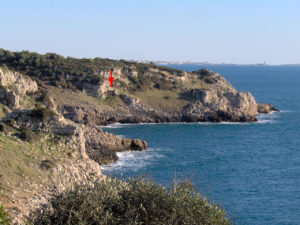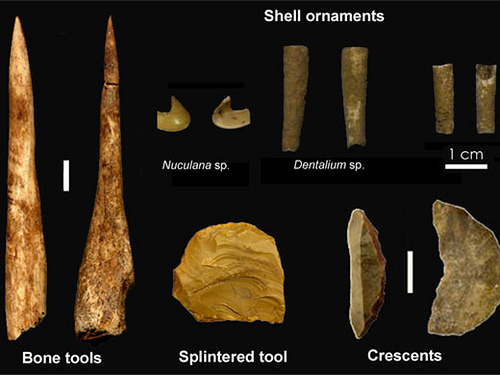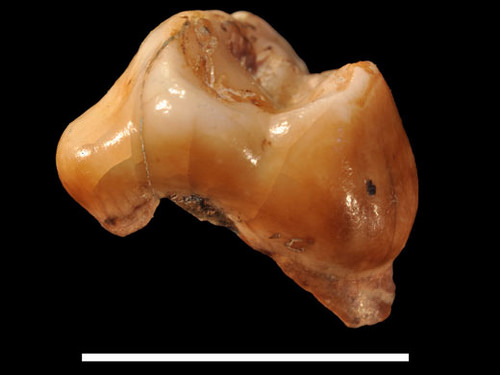
Researchers have securely dated a prehistoric human stone tool industry that is thought to have been used by early modern humans, or possibly late Neanderthals, around the time when early modern humans were beginning to emerge in Europe, arguably sometime between 40,000 to 50,000 years B.P.
Scientists have long debated questions surrounding when the first modern humans entered Europe and what tools they first used upon entering. The Uluzzian, a prehistoric stone tool techno-tradition represented by lithic artifacts unearthed by archaeologists at cave locations primarily in Italy and Greece, has been a central contender as a possible “transitional” industry between the typical stone tool types (the Mousterian) used by late European Neanderthals and those (Aurignacian, Châtelperronian) of the earliest modern human newcomers to Europe. Uncertainty and debate has historically characterized the exact chronology of the Uluzzian techno-complex, including the identification of the species of human that made and used them. Research within the past few years, buttressed by association of early modern human fossils found in context with Uluzzian tools, has strengthened the suggestion that they belonged to early modern humans.
Now, an international scientific team led by Katerina Douka of the University of Oxford is reporting the results of a new study, concluding that the Uluzzian arose or arrived in what is present-day Italy and Greece shortly before 45,000 years ago, with its latest phases placed at around 39,500 years ago, and “its end synchronous (if not slightly earlier) with the Campanian Ignimbrite eruption”.* The Campanian Ignimbrite eruption refers to the eruption of the Archiflegreo volcano around 37,000 years B.P., coincidental or correlated to Middle Paleolithic (beginning 300,000 years ago) to Upper Paleolithic (beginning between 50,000 and 40,000 years ago) cultural transitions and the theorized replacement of Neanderthal populations by anatomically modern humans in southeastern Europe. The replacement theory and the Archiflegreo volcanic eruption as a causal element within this model has been a subject of continuing debate.
To determine the new dates, the researchers integrated the results of new radiocarbon dating tests and a Bayesian statistical approach on samples from four caves where Uluzzian artifacts have been found in Italy and Greece (Cavallo, Fumane, Castelcivita and Klissoura 1). In addition to constructing a new chronology for the Uluzzian, they also examined the culture’s appearance, its time and space spread and its correlation to earlier and later Palaeolithic stone tool assemblages (i.e., Mousterian, Protoaurignacian) within the relevant geographic regions.
The Uluzzian was first discovered in the early 1960s at the site of Grotta del Cavallo in southern Italy. This cave yielded about 7 meters of archaeological deposits representing the period during which scientists have suggested that Neanderthals were replaced by modern humans. Two milk teeth, attributed at the time to Neanderthals, were unearthed in 1964 by Arturo Palma di Cesnola (emeritus of the University of Siena) from the Uluzzian layers. The Uluzzian culture has been identified at more than 20 separate sites across Italy, and is characterised as consisting of an array of denticulates, sidescrapers, retouched pieces and splintered pieces, distinguished by a production process that differed from that of the earlier Mousterian (associated with Neanderthals) and the proto-Aurignacian (associated with early modern humans).* Finds have also included what has been interpreted as personal ornaments, bone tools and colourants; items typically associated with modern human symbolic behaviour. Because the teeth from Cavallo were identified as belonging to Neanderthals who lived around 200,000 to 40,000 years ago, it was suggested that the Uluzzian and the complex ornaments and tools within it were also produced by Neanderthals.* But in a study published in 2011 in the journal Nature, Stefano Benazzi of the University of Vienna and his colleagues were able to compare digital models derived from micro-computed tomography scans of the human remains from Grotta del Cavallo with those of a large modern human and Neanderthal dental sample: “We worked with two independent methods: for the one, we measured the thickness of the tooth enamel, and for the other, the general outline of the crown. By means of micro-computed tomography it was possible to compare the internal and external features of the dental crown. The results clearly show that the specimens from Grotta del Cavallo were modern humans, not Neanderthals as originally thought.”**
__________________________________________________________________________________________
Uluzzian artifacts from Grotta del Cavallo, Apulia, southern Italy. Credit: Annamaria Ronchitelli and Katerina Douka
________________________________________________________________________________________
Mesial view of the specimen Cavallo-B (deciduous left upper first molar). The white bar in the figure is equivalent to 1 cm. Credit: Stefano Benazzi
_________________________________________________________________________________________
The most recent study is published in the Journal of Human Evolution.
________________________
*http://dx.doi.org/10.1016/j.jhevol.2013.12.007
** The Early dispersal of modern humans in Europe and implications for Neanderthal behaviour.
Benazzi, S., Douka, K., Fornai, C., Bauer, C.C., Kullmer, O., Svoboda, J., Pap, I., Mallegni, F., Bayle, P., Coquerelle, M., Condemi, S., Ronchitelli, A., Harvati, K., Weber, G.W. In. Nature, Nov. 3, 2011. DOI 10.1038/nature10617
Cover Photo, Top Left: The Grotta del Cavallo (red arrow) opens on the bay of Uluzzo, which is located in the Regional Natural Park of Portoselvaggio, Apulia, southern Italy. Credit: Annamaria Ronchitelli
_________________________________________________________________________________________
Read about the most fascinating discoveries with a premium subscription to Popular Archaeology Magazine. Find out what Popular Archaeology Magazine is all about. AND MORE:
 On the go? Purchase the mobile version of the current issue of Popular Archaeology Magazine here for only $2.99.
On the go? Purchase the mobile version of the current issue of Popular Archaeology Magazine here for only $2.99.
And, Popular Archaeology’s annual Discovery edition is a selection of the best stories published in Popular Archaeology Magazine in past issues, with an emphasis on some of the most significant, groundbreaking, or fascinating discoveries in the fields of archaeology and paleoanthropology and related fields. At least some of the articles have been updated or revised specifically for the Discovery edition. We can confidently say that there is no other single issue of an archaeology-related magazine, paper print or online, that contains as much major feature article content as this one. The latest issue, volume 2, has just been released. Go to the Discovery edition page for more information.
Subscription Price: A very affordable $5.75 for those who are not already premium subscribers of Popular Archaeology Magazine (It is FREE for premium subscribers to Popular Archaeology). Premium subscribers should email [email protected] and request the special coupon code. Or, for the e-Book version, it can be purchased for only $3.99 at Amazon.com.







